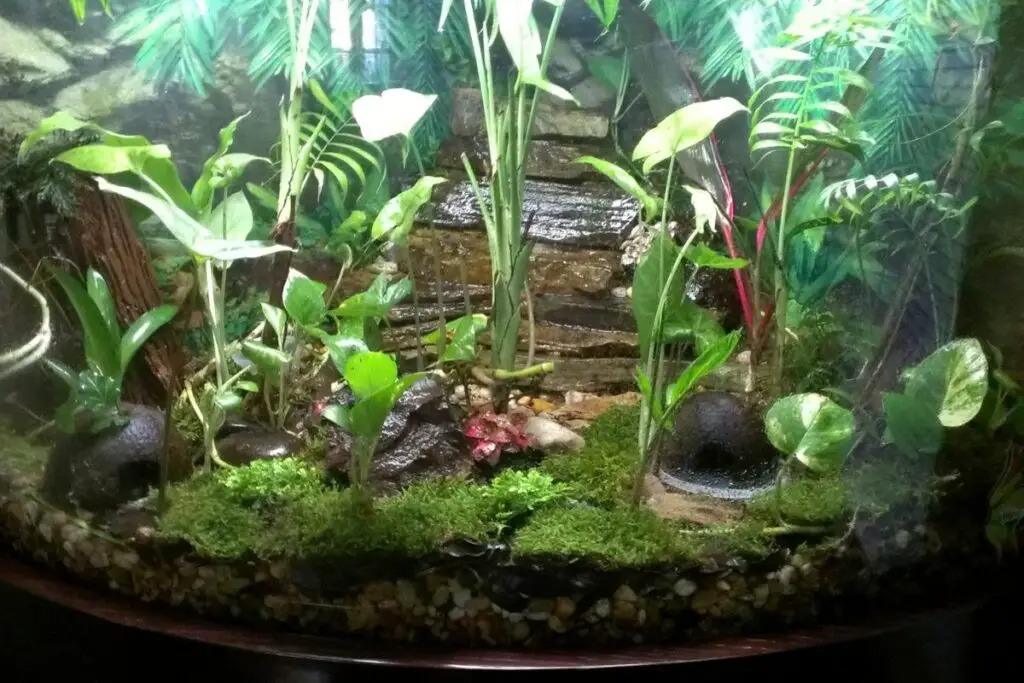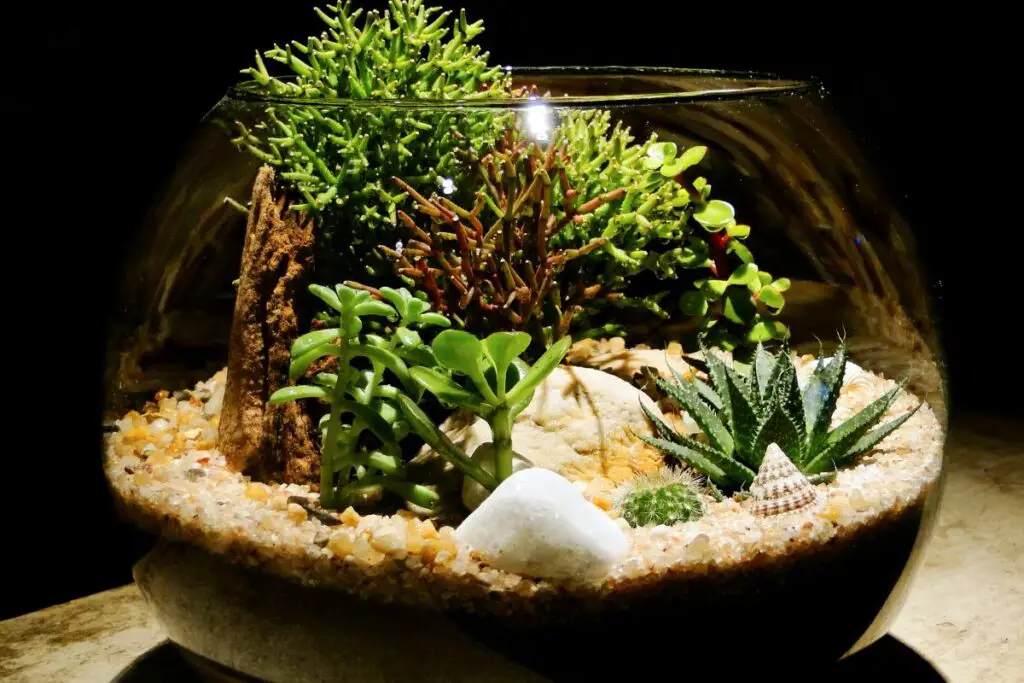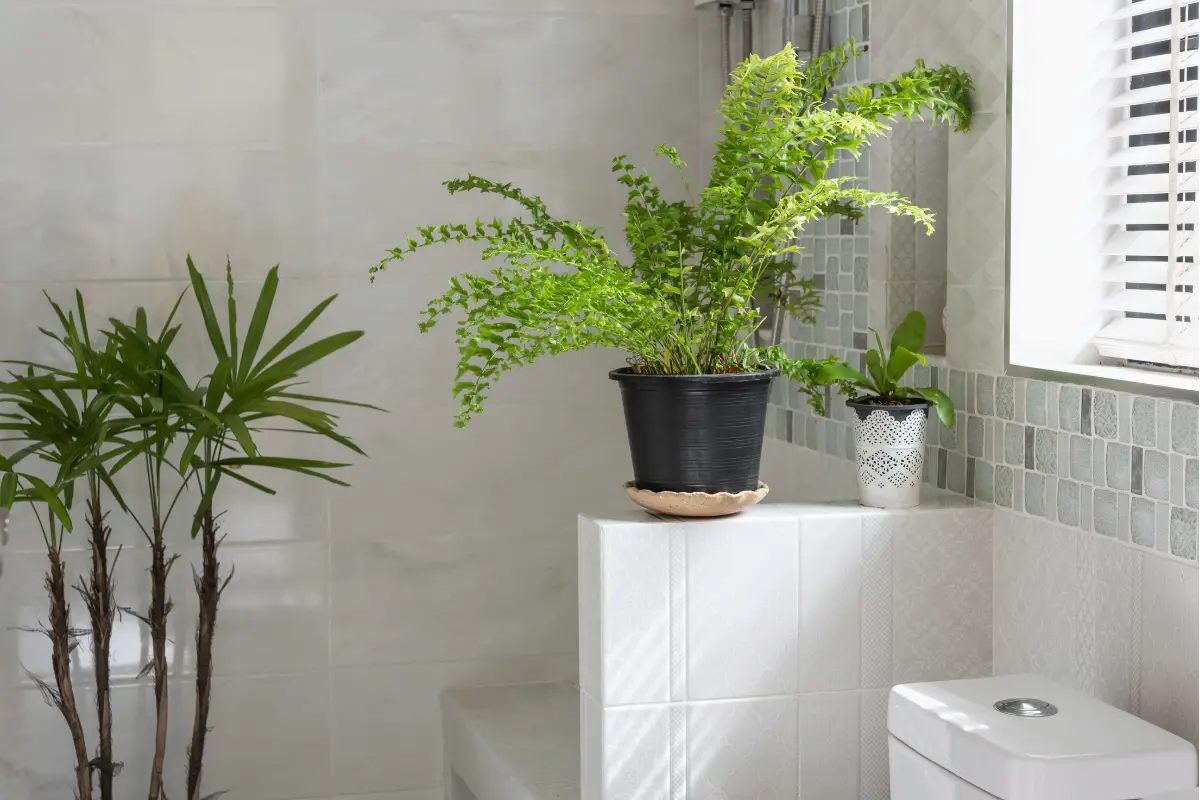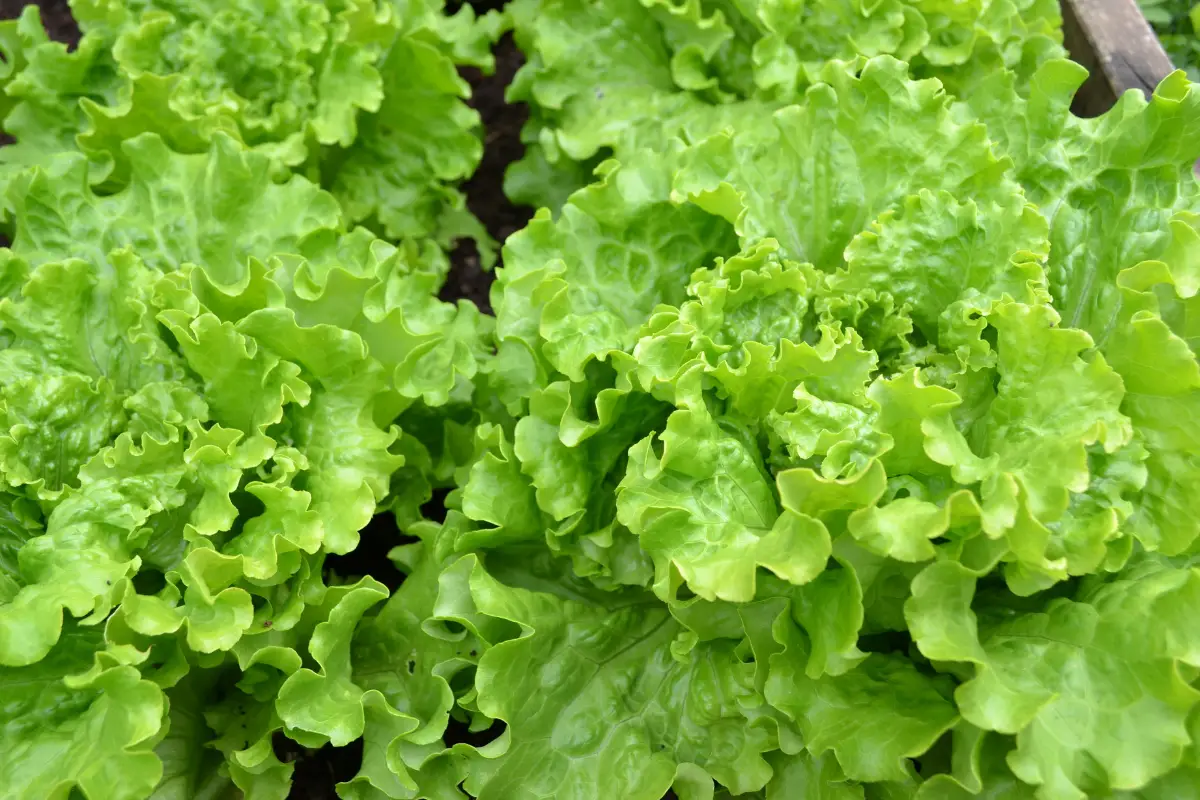Many people use the word “terrarium” to refer to any enclosure that contains a miniature garden. More specifically, a terrarium is an enclosure that you keep plants in, while a vivarium houses animals. However, there are more differences to learn about.
If you’re interested in discovering more about the differences between a vivarium and a terrarium, you’ll want to keep reading.

How you set up and care for each is different, so you must understand when to use each.
Table of Contents
What’s a Vivarium?
A vivarium is an enclosed setup where you can raise animals. The enclosure creates stable conditions for reptiles and allows you to observe your pets closely. They’re mainly for animals that wouldn’t do well in your home’s temperature or humidity conditions.
For example, vivariums work great for reptiles because they allow you to establish and monitor humidity conditions where they can thrive.
The materials, temperature, and humidity in the vivarium will depend entirely on the animal living there. Many reptile species have different environmental conditions they need to survive, so most vivariums will be drastically different from one another.
For instance, a snake and a gecko will require different temperatures, moisture, and decorations to be healthy in a vivarium.
Many people refer to vivariums as terrariums, although they are slightly different.
What’s a Terrarium?
Terrariums are small gardens enclosed inside glass tanks. While they may look very similar to vivariums, they rarely have any life inside them, aside from plants.
These containers can create perfect conditions for plants you wouldn’t be able to grow in your house otherwise.
After you build your terrarium, you can work on making it autonomous. The plants will continue getting the water they need as water evaporates and “rains” back into the tank. With the correct humidity and temperature, you can get the terrarium to water itself for long periods.
You usually fill terrariums with plants that love warmth and humidity but are also tiny. Mosses and ferns tend to fit those conditions well. Although, you can always decorate your terrarium however you’d like.
Overall, terrariums have a stronger focus on plants than vivariums do. Sometimes people use the word terrarium for a vivarium, but you can tell which it is by the number of plants.
- Large Glass House Terrarium-- Made of premium quality, smooth, transparent, beautifully shaped glasses.The Wood Base and wooden ball is coated with a spray of polyester paint to form a sealing layer, no mildew .
- Size--Height:7/Width:6/Opening: 3.15. This opening allows you to place your plants normally, or you can use hand tools for your plant arrangement.
- Gardern DIY-- You can create house for plant such as fern, moss, succulents, airplants or display a small garden, or even as a great table centrepiece for wedding, office desk, balcony, coffee table, etc.
- Miniature Goldfish Bowl--Such an attractive fish bowl placed on the table of your room or office will make you feel good and relaxed in the busy day.
- Warranty - Plants not included. We are passionate about our environment and use these large glass terrarium in our home.If you receive damaged or not satisfied with your purchase,Please contact us,we will replace it or refund right away.
Prices pulled from the Amazon Product Advertising API on:
Product prices and availability are accurate as of the date/time indicated and are subject to change. Any price and availability information displayed on [relevant Amazon Site(s), as applicable] at the time of purchase will apply to the purchase of this product.
Terrariums will have many more plants than other tank setups.
What are the Differences Between Vivariums and Terrariums?
At first glance, a vivarium and a terrarium can look very similar to one another. The terrarium will have more plants, in most cases, although there are more differences than just that.
Let’s break down all of the most important differences between these two types of tanks together:
- Terrariums are more natural: Terrariums can replicate natural processes, such as the rain cycle. They can be fully self-sufficient, requiring little assistance to remain healthy and thriving.
- Vivariums need more help: If you’re keeping a vivarium, it will be much more hands-on. You’ll need to install light sources, filters, and more to keep it in good condition.
- These tanks have different constructions: Vivariums are much larger, so they can fit filters, fans, and additional light sources. Terrariums are tiny, so they can’t fit any of these extra tools, although they don’t need them. You can’t use the two interchangeably due to their varying constructions.
- Different plants thrive in them: You can’t plant the same plants in a vivarium as in a terrarium and expect to get good results.
- They have different sun requirements: Terrariums need a lot of sunlight to be self-sufficient. The light starts the rain cycle process and allows the plants to perform photosynthesis. Not all reptiles will want a lot of natural sun, so many vivarium keepers use heat lamps for their pets. They can also turn them off when it’s time for the reptile to go to bed to encourage healthy sleeping patterns.
Do The Names Mean Something Different?
There are many types of “-ariums” out there, and each has a different meaning. The suffix “-arium” denotes a place. So, for example, an aquarium is a “water place.” A mossarium is a place for growing moss. People have always enjoyed raising life in small tanks, so plenty of “-ariums” are out there!
That also means that a terrarium would be a “land place,” and a vivarium would be “a place of life.” So, terrariums focus on “land,” including plants and soil.
A vivarium instead emphasizes an environment suitable for animals to live in. While they can still house plants, the focus is more on the animal inside the enclosure than the plants.
Suppose you’re trying to determine whether a tank is a vivarium or a terrarium. In that case, you’ll need to consider the priority of the enclosure.
If the tank’s focus is to create a place where plants thrive, it’s a terrarium. If it’s making a stable environment for a reptile, it’s a vivarium.
In short, these two words do have very different meanings, despite having the same suffix. Breaking the word apart can help give you a better idea of what should go inside that tank.

Are Terrariums or Vivariums Easier To Keep?
Terrariums are much easier to keep than vivariums. Once you have an established terrarium, it should take care of itself.
You can create many designs and setups using various plants, too, so many people enjoy having more than one at a time to experiment with.
Vivariums, however, house a pet, usually some kind of reptile. Of course, you couldn’t leave a reptile in a tank alone and expect it to be self-sufficient.
It will rely on you to take care of its tank’s conditions so it can survive and remain healthy.
You’ll need to monitor the temperature and humidity closely. Plus, you’ll need to clean the vivarium much more often to keep it sanitary for your reptiles. Vivariums also require more equipment, which you’ll need to monitor and replace when they wear out.
Vivariums are also much more expensive over time for that exact reason. Plus, you’ll need to pay to feed your reptiles.
So, we’d have to say that terrariums are much easier to keep. You can start with one and see how you feel, then move on to designing your vivarium. You’ll notice that the vivarium is much more involved.
How Often Do Terrariums Need Water?
Terrariums don’t need you to water them very often at all. Since it’s an enclosed system, water can’t escape from the tank. Most terrariums only need water every three months. However, some terrariums with a tighter seal never need watering again.
If you have plants in a vivarium, you’ll need to water them much more frequently since the water can evaporate from the tank. You may need to mist any live plants inside the vivarium multiple times per week.
How Often Do You Change Vivarium Sand?
Vivariums often use sand, or other materials, as a substrate. Changing the sand at least once a week prevents bacteria from growing there. It also helps the enclosure smell clean and keeps your reptiles happy.
Once you set up your terrarium, you don’t need to change the substrate. Terrariums don’t need to be cleaned nearly as often as vivariums. You’ll only need to wipe the glass from time to time if it’s hard to see inside the terrarium.
You can also remove dead leaves to prevent mold from spreading inside the tank. But you won’t need to clean your terrarium very often, if at all!
Do They Need Added Ventilation?
Vivariums often need more ventilation to make sure your pets are comfortable. Fans can add ample airflow, which helps your reptiles breathe.
That said, you don’t want any ventilation in terrariums. Water will escape if there is a way for air to get in and out. You won’t be able to establish a rain cycle in the terrarium that way.
You won’t need to worry about the plants being unable to breathe. They absorb oxygen and use it to make carbon dioxide.
Then, the plants use carbon dioxide during photosynthesis and produce more oxygen. It’s an unending cycle, so you don’t need to add more air vents to the terrarium. Doing so can disrupt this self-sufficient cycle.
So, vivariums need additional ventilation, but terrariums are fine without it. You’ll need to research what kinds of ventilation the creatures you keep in the vivarium prefer.
What Materials Can They Consist Of?
Terrariums must consist of glass or plastic because light must enter the tank. Sunlight causes the rain cycle system to run correctly and is essential for plants to do photosynthesis.
So, the material the terrarium is made from needs to be transparent.
A vivarium can consist of a broader range of materials since they don’t always need to be translucent.
Glass is the most common choice, but it can also use wood. Although, many vivarium keepers prefer to use transparent materials so they can see into the tank easily.
To summarize, you might find vivariums made from various materials, while terrariums are almost always glass or plastic.
Conclusion
In conclusion, a vivarium is a living space that is used to house animals such as reptiles, amphibians, and insects, while a terrarium is a container that is used to grow plants.
The main difference between the two is the type of living organism that they are designed to support.
While both types of enclosures can be used to create beautiful and naturalistic environments, they have different requirements and considerations.
Additionally, vivariums often have specific needs for lighting, heating, and humidity, while terrariums focus more on providing the right type of soil, drainage, and light for the plants.
- How to Build a Planter Box for Bamboo: A Step-by-Step Guide

- Can Robotic Lawnmowers Handle Steep Slopes?

- Do You Need a Specific Lawn for a Robotic Lawnmower? Expert Advice

- Are Robotic Lawnmowers Safe for Pets and Children? Safety Features of Robotic Lawnmowers

- Why Use Robotic Lawnmowers? Advantages of Using a Robotic Lawnmower

- Is the GARDENA SILENO City 300 Cordless or Corded? A Clear Answer





















